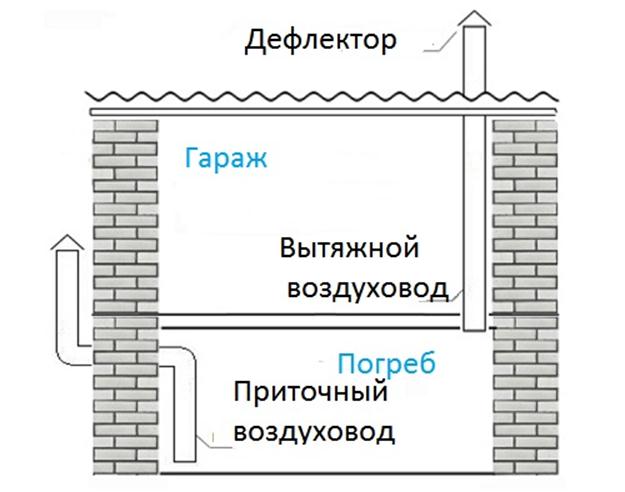Search
Login
We build a cellar with our own hands, how to choose the right place for a cellar, cellar construction options
It is difficult to do without such a structure as a cellar having a private house. Sooner or later, the question arises of where to store vegetables, fruits, various food preparations, so it’s better to immediately consider the design of the cellar. To do this, you should study the relief of the site, it is better to choose a slope or the driest place, know the level of groundwater, the structure of the soil, the depth of its freezing.
Content
- The groundwater video
- Soil types
- Cellar bookmarking guidelines video
- Mini cellar
- Semi-buried cellar
- Useful cellar care tips
- Wiring in the cellar
The groundwater
It is at least approximately important for the owner of the site to know about the level of groundwater occurrence in their area and to distinguish their types.
All water located below the earth's surface is called underground, they are divided into several types of water:

- over-watering - is formed from melting snow or prolonged rains. This water is seasonal or temporary and usually does not have a constant supply;
-ground waters are formed by atmospheric precipitations filtered through the soil, and waters of other aquifers.
The groundwater level must be at least 0.5 meters below the cellar floor level, if the groundwater is located below 2.5 meters from the ground, the cellar can be buried up to 2 meters.
The proximity of groundwater can be determined by vegetation: among the vegetation, marsh and hygrophilous herbs predominate, such as reeds, sorrel, coltsfoot, horsetail, sedge. The best way to determine the occurrence of groundwater is: take a ball of wool, degrease it in soapy water, and dry it. We take a piece of land, clearing it of turf, put wool on this place, and a freshly laid egg on top of it, All this is covered with a frying pan or clay pot, and the shot turf is put on top of them. The next day, after sunrise, the result is determined. If the egg is dry and the coat is wet, the water is deep. If both the coat and the egg are dry, the water is very deep. Great place for a cellar. If the wet and the egg and wool, water is close. It is important to remember that this technique is effective only in stable, dry weather.
Soil types
The composition of the soil is divided into clay, loamy, sandy, sandy loam. There is a mechanical way to determine the type of soil. To do this, pick up a lump of moist earth and roll it into a tourniquet, then fold it into a ring. If the ring is smooth, clay soil, if the ring has cracks, loam, if the ring does not form at all, the soil is sandy.
Cellars according to their structure are divided into land, half-buried, buried.
Cellar bookmarking guidelines
Any underground structures dig in the summer, when groundwater sinks to a minimum mark. For the convenience of performing concrete and waterproofing works, the foundation pit is dug approximately 60 cm wider and deeper than the cellar under construction.

The walls of the cellar are best made monolithic from dense concrete (for two parts of sand we take one part of cement m-500) with a thickness of 20-30 cm, be sure to lay reinforcement or rods from steel wire, or from concrete blocks.

Mount two ventilation pipes 15x15 cm in the cellar. It is better to place them on opposite walls. The exhaust short pipe is located under the ceiling itself, and the second air inlet at a height of 50 cm from the floor comes out at the same height as the exhaust, you can arrange forced ventilation, for which they use a fan, placing it on the exhaust pipe. Fan power is calculated by the formula volume multiplied by five cubic meters per hour.

If your soil is saturated with water, then before digging a pit along the perimeter of a future cellar, dig holes that are about 50 cm deep and 40 cm in diameter - pits for collecting water. Draining water must be removed as the pits are filled. Deepening into the ground, the pits will also have to be deepened. Level the bottom of the pit, tamp, fill it with gravel, 8-10 cm thick., Lay a layer of crumpled oily clay 2-3 cm on top, lay it out and compact. On top, not letting the clay dry, concrete is poured 10 cm thick. The concrete grade is not lower than M300. After 10-15 days, a cement screed of 5 cm thickness is laid on top.

For external waterproofing of the walls, to create a thin waterproof film with a thickness of about 2 mm., Usually use heated bitumen. But before starting waterproofing work, level the surface of the walls and plaster with cement mortar (cement and sand in a ratio of 1: 2), rub well and cover with bitumen. Instead of bitumen, you can use penetrating waterproofing for concrete (squid, penetron, etc.)
1. Basement wall.
2. Layer of cement mortar.
3. Filling of cobblestone.
4. A layer of gravel.
5. Pipe.
6. Clay.
If the soil is dense, clayy, which contributes to the stagnation of water between the cellar wall and the ground, make a clay lock: tighten all the cavities with clay, laying it in layers and compacting 20-30 cm. An annular drainage must be made at the bottom of the cellar, for this you can use perforated asbestos-cement, ceramic or plastic pipes as well as stone or gravel. When constructing an annular drainage, it is necessary to dig a trench, the bottom of which is below the level of the cellar floor. If it is not possible to divert the collected water to the cuvette, consider discharging water from the catchment well (it should be 0.5 to 1 meter below the cellar depth).

The size of the hatch is usually made 75x75 cm. It is made of sheet steel with a thickness of 1.5-2 mm. and corner trim, Insulating from the inside with a mineral wool slab, followed by wood lining. Warm the cellar ceiling with a claydite layer with a thickness of 10-20cm. Lay concrete screed reinforced with metal mesh on expanded clay. It is advisable to build a gazebo over the cellar. The cellar can be made under the garage or during the construction of the house. For the safety of lighting in the cellar, you need to install a step-down transformer from 220 volts to 12 volts, only 12 volts should be put into the cellar. The wires must be laid in the corrugation and the cover is waterproof.
Mini cellar
The ground mini-cellar is built like this:
- at a chosen place they dig a hole 30-50 cm deep., dimensions along the perimeter at the discretion of the owner;
- bottom tamped, 10 cm., covered with drainage materials: expanded clay, coarse sand, fine gravel;

- a layer of soft clay, up to 20 cm thick, is laid on top, a red, burnt brick is buried flat into the clay, thus producing a floor, one meter square floor, 32 bricks go;
- a box is built with tightly knocked double walls from thick boards up to 50 mm., a heat-insulating material (any insulation) is laid in the gap between the walls of the box. This box is placed on the floor;
- the walls of the cellar are insulated, to prevent blowing from the outside, sheathed with roofing material or thick construction cardboard;

-On the front side of the cellar a manhole is made measuring 0.6 by 0.8 meters, two doors are fastened, between which a heater is laid for the winter. On the same side from the top arrange a window with a size of 10x10 cm, which serves for ventilation. From above, the cellar is covered with a light one or two-pitched roof from a slab covered with roofing material;
- around the cellar at a distance of 1 or 1.5 meters from the walls, make a drainage ditch 0.5 meters deep, half filled with draining material (brushwood, gravel, etc.).
Semi-buried cellar
This is the most common type of cellar, build it as follows:

- the basement of the cellar is buried only 0.7-1 meters from the surface of the earth, this allows you to build it in wet places. If during the excavation of the pit the aquifers are exposed, they are immediately covered with crushed fat clay in five layers of 10 centimeters each;
- the walls of the cellar are made of concrete or brick;
- the ceiling is made of slab, protecting it from moisture with clay grease, roofing material is laid on top. Waterproofing is done depending on local conditions.
Useful cellar care tips
humidity in the cellar
Moisture formation begins at 100% humidity, if the walls become wet, mold appears and vegetables are moistened - humidity is more than 95%. Reasons - the ceiling is poorly insulated, the waterproofing of the ceiling and walls is broken, the ventilation does not work well. In the summer, such a cellar should be inspected and repaired. If the air in the basement is very dry, bring a box of sand, periodically moisten it. If the humidity is above normal, put a bucket of hydrated lime, it absorbs excess moisture.
cellar disinfection
Of great importance are measures to disinfect the cellar. Well destroy mold, fungi and insects fumes that are formed from the extinction of bleach. To do this, put 2-3 kg in the tank. quicklime, pour water, quickly leave the room, the cellar is tightly sealed. After 1 - 2 days the cellar is aired, it is good to hold such a reception 2-3 times with a break of a week. It is also good to fumigate with a sulfur checker. In summer, you need to dry all the shelves and boxes, whitewash the cellar from the inside with lime mortar with copper sulfate.
It must be remembered that after processing and disinfecting the cellar, there is a need for hand treatment. In this regard, I would like to offer Grass products. Grass detergents and cleaning products can buy and you can forget about the infection.
cellar ventilation
The cellar must be provided with good supply and exhaust ventilation. To do this, install two pipes placed in two levels and in different places in the cellar.

Signs of inadequate ventilation:
- musty, stale air;
- a feeling of dampness;
- the appearance of mold;
To reduce the humidity, arrange through ventilation, at the same time make quicklime.
condensate and drip removal
To eliminate this drawback, it is necessary to insulate the cellar ceiling, for example, expanded clay, forest moss, they have the ability to quickly suck out moisture and dry out. Condensation and drip from the ceiling are removed using galvanized iron or plastic umbrellas.
electrical wiring in the cellar
due to high humidity, the cellar is a particularly hazardous area, therefore, increased requirements are imposed on electrical wiring, namely:
- use step-down transformers;
- electrical wiring is performed in a corrugated metal hose;
- use tight lamps;
- the switch is mounted outside the cellar;





